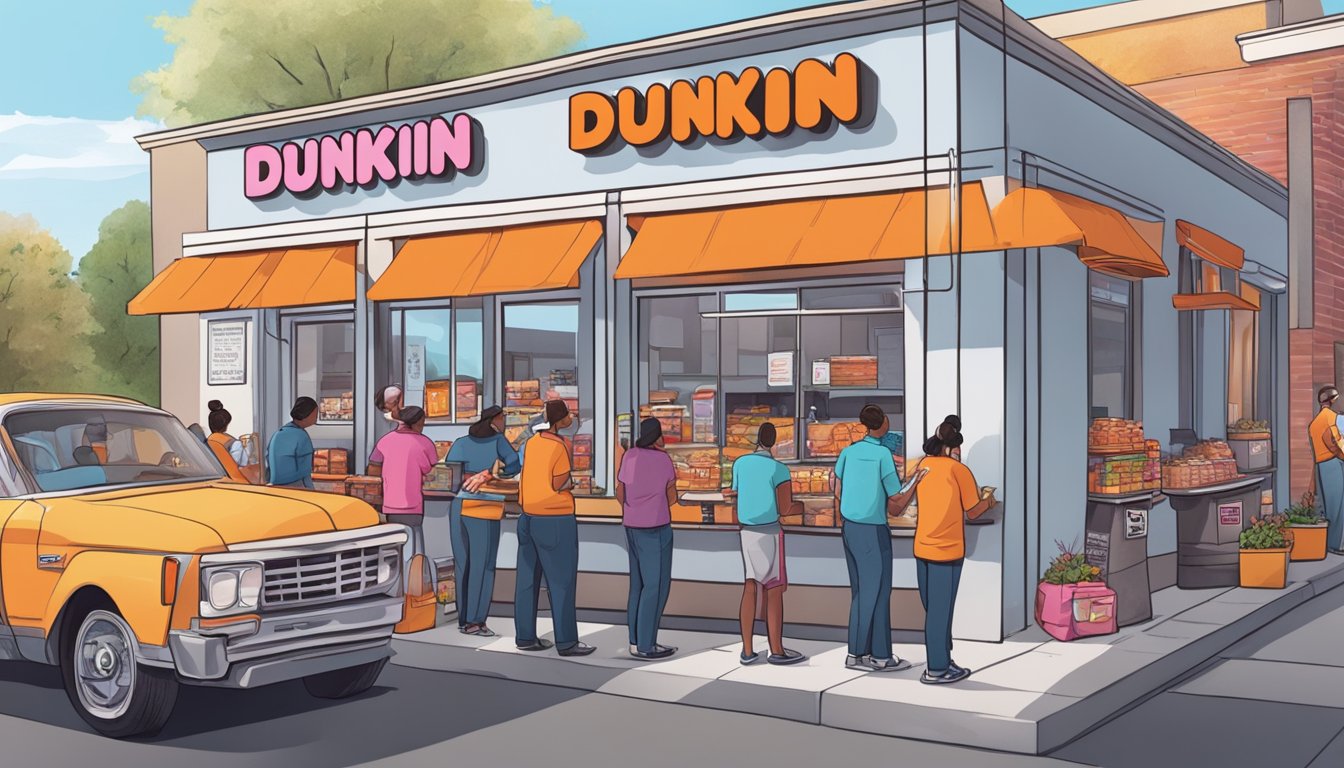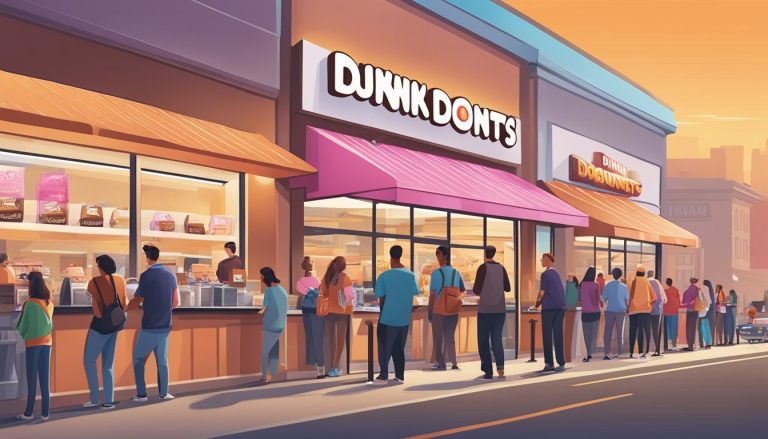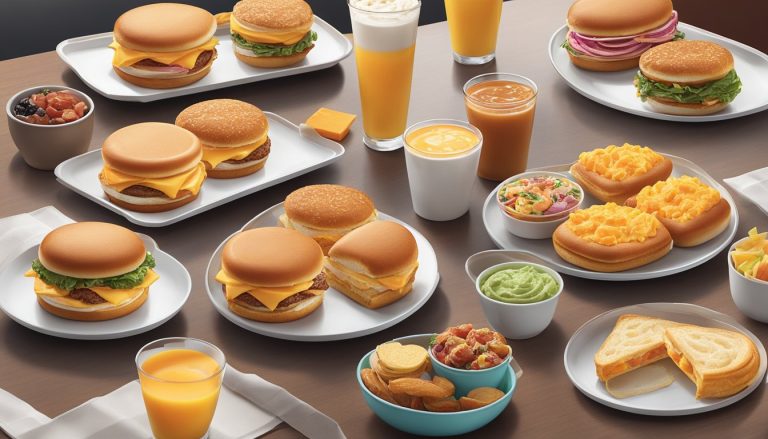Dunkin’ has mastered the art of drive-thru efficiency, setting a new standard in the fast-food industry. The coffee giant‘s commitment to speed and convenience has made it a favorite among busy consumers seeking quality beverages on the go. Dunkin’s average total drive-thru time of 176.20 seconds demonstrates their dedication to rapid service without compromising quality.
This remarkable efficiency is no accident. Dunkin’ employs advanced strategies and technologies to streamline their drive-thru operations. From optimized ordering systems to well-trained staff, every aspect of the drive-thru experience is carefully engineered to minimize wait times and maximize customer satisfaction.
The science behind Dunkin’s drive-thru success extends beyond mere speed. By focusing on accuracy and maintaining a consistent level of service, Dunkin’ has created a reliable experience that keeps customers coming back. This blend of efficiency and quality has positioned Dunkin’ as a leader in the competitive world of fast-service coffee and donuts.
The Evolution of Dunkin’s Drive-Thru

Dunkin’ has consistently adapted its drive-thru strategy to meet changing consumer needs and technological advancements. This evolution has played a crucial role in the brand’s growth and market position.
Historical Perspectives
Dunkin’ Donuts introduced drive-thru service in the 1970s, recognizing the growing demand for convenience among American consumers. The initial focus was on speed and efficiency, with a limited menu to ensure quick service.
In the 1990s, Dunkin’ expanded its drive-thru offerings to include a wider range of coffee drinks and food items. This shift aligned with changing consumer preferences and helped Dunkin’ compete more effectively in the growing coffee market.
By the early 2000s, Dunkin’ had established drive-thrus as a core part of its business model. The company invested in training programs to improve order accuracy and reduce wait times.
Drive-Thru Innovation and Growth
Dunkin’ has embraced technology to enhance its drive-thru experience. In 2018, the company launched its first drive-thru dedicated to mobile pickup orders placed through the DD Perks app. This innovation significantly reduced wait times for customers.
Digital menu boards were introduced to improve order clarity and promote new products. These boards can be updated in real-time, allowing for dynamic pricing and menu adjustments based on inventory or time of day.
Dunkin’ has also experimented with dual-lane drive-thrus at high-volume locations. This design increases capacity and reduces congestion during peak hours.
Comparisons With Competitors
Dunkin’s drive-thru strategy differs from competitors like Starbucks in several key ways:
- Speed: Dunkin’ prioritizes quick service, with shorter average wait times than Starbucks.
- Menu: Dunkin’ offers a more streamlined menu, focusing on coffee and baked goods.
- Technology: While both chains have invested in mobile ordering, Dunkin’ was quicker to implement dedicated mobile pickup lanes.
Compared to other quick service restaurants, Dunkin’ has maintained a strong focus on its coffee offerings. This specialization has allowed for more efficient drive-thru operations compared to chains with more complex menus.
Dunkin’s drive-thru innovations have helped it compete effectively against both coffee-focused chains and broader quick-service restaurants. The company’s ability to balance speed, quality, and convenience has been key to its continued success in the competitive coffee market.
Strategic Location and Accessibility
Dunkin’ strategically selects drive-thru locations to maximize visibility and convenience for customers. This approach focuses on high-traffic areas and easy access points to enhance the overall customer experience.
Site Selection for Drive-Thrus
Dunkin’ prioritizes locations with high visibility and easy access from main roads. The company targets busy intersections, shopping centers, and areas near highway exits. These spots ensure a steady flow of potential customers throughout the day.
Drive-thru sites are chosen based on factors like traffic patterns, population density, and proximity to residential or commercial areas. Dunkin’ also considers the surrounding competition and local zoning regulations when selecting locations.
The ideal site allows for smooth traffic flow both on the property and surrounding streets. This includes ample space for queue lines and clear entry/exit points to minimize congestion.
Impact on Traffic Flow and Convenience
Well-designed Dunkin’ drive-thrus aim to process orders quickly and efficiently. This reduces wait times and improves the overall customer experience. Strategic location choices help minimize disruptions to local traffic patterns.
Dunkin’ often positions drive-thru windows on the right side of the building for easy access. This setup allows customers to enter and exit the property smoothly without crossing oncoming traffic.
Some locations feature dual drive-thru lanes to handle higher volumes during peak hours. This design helps reduce line buildup and keeps traffic moving on nearby streets.
Dunkin’ also considers pedestrian accessibility in their site layouts. This includes safe walkways and crossings for customers who prefer to park and enter the store.
Enhancing Speed of Service

Dunkin’ Donuts prioritizes swift service at drive-thrus to meet customer expectations. Key areas of focus include streamlining operations, training staff effectively, and leveraging technology.
Operational Efficiency
Drive-thru layouts are optimized to minimize bottlenecks. Strategically placed menu boards and speaker systems reduce order times. Dedicated lanes for mobile orders help separate traffic flows.
Drink and food preparation areas are designed for maximum efficiency. Popular items are placed within easy reach. Pre-packaged products speed up order fulfillment.
Dunkin’ analyzes peak hours and staffs accordingly. More employees are scheduled during rush periods to maintain quick service. Cross-training allows staff to switch roles as needed.
Employee Training and Performance
Comprehensive training programs equip staff with skills to handle drive-thru demands. Employees learn order-taking techniques, multitasking, and efficient food preparation.
Speed targets are set and monitored. Staff receive regular feedback on their performance. Incentives reward teams that consistently meet or exceed speed goals.
Standardized procedures ensure consistency across shifts and locations. Checklists guide employees through tasks efficiently. Regular drills help staff practice handling high-volume periods.
Technology Integration
Digital menu boards display real-time updates, reducing indecision and speeding up ordering. AI-powered systems can suggest add-ons based on customer preferences.
Mobile ordering apps allow customers to place orders in advance. Dedicated pickup areas streamline the process for these pre-paid transactions.
Kitchen display systems coordinate food preparation with incoming orders. Automated drink machines reduce preparation time.
Voice recognition software improves order accuracy and speed. Contactless payment options cut transaction times at the window.
Leveraging Technology for Efficiency
Dunkin’ Donuts has embraced technological solutions to streamline operations and enhance customer experience. These innovations span mobile ordering, app-based features, and delivery services.
Mobile Ordering and the Dunkin’ App
The Dunkin’ mobile app revolutionizes how customers interact with the brand. It allows users to place orders remotely, skip lines, and earn rewards. The app integrates seamlessly with drive-thru operations, reducing wait times and improving order accuracy.
Customers can customize their drinks and food items through the app interface. This feature minimizes errors and ensures patrons receive exactly what they want. The app also stores favorite orders, making repeat purchases quick and convenient.
Payment through the app is secure and swift. Users can link credit cards or use mobile payment options, further speeding up transactions at the drive-thru window.
On-the-Go Ordering Features
On-the-Go ordering is a cornerstone of Dunkin’s digital strategy. This feature enables customers to order ahead and pick up their items without waiting in line. It’s particularly beneficial for drive-thru efficiency.
Customers select a pickup time and location through the app. The system then ensures orders are prepared fresh and ready for collection at the specified time. This reduces congestion at the drive-thru and improves traffic flow.
Geofencing technology alerts store staff when an On-the-Go customer is approaching. This allows for precise timing in order preparation, ensuring food and drinks are at optimal temperature upon pickup.
Delivery Services Evolution
Dunkin’ has expanded its reach through partnerships with third-party delivery services. This move caters to customers who prefer at-home or office consumption without visiting a store.
The company has integrated its menu and ordering systems with popular delivery platforms. This seamless connection ensures accurate order transmission and efficient preparation.
Dunkin’ has also implemented dedicated pickup areas for delivery drivers. This separation from regular drive-thru traffic helps maintain speed of service for all customer types.
The brand continues to refine its delivery offerings, exploring options like in-house delivery services in select markets. These efforts aim to provide more control over the delivery experience and maintain Dunkin’s quality standards.
Menu Innovation and Product Offering

Dunkin’ has consistently evolved its menu to meet changing consumer preferences and drive sales growth. The company focuses on expanding beverage options while maintaining its core donut offerings.
Diverse Menu and Seasonal Offerings
Dunkin’ offers a wide range of food and beverage items beyond traditional donuts. The menu includes breakfast sandwiches, wraps, bagels, and muffins. Seasonal promotions introduce limited-time flavors and products to generate excitement and repeat visits.
Dunkin’ has streamlined its menu, reducing food options by 10% to emphasize drinks. This shift aims to boost coffee sales and simplify operations. Despite this change, donuts remain a core part of Dunkin’s identity and product lineup.
The company collaborates with culinary experts to develop new items that align with consumer trends and preferences. This approach helps Dunkin’ stay competitive in the fast-paced quick-service restaurant market.
Cold Brew and Beverage Trends
Dunkin’ has embraced the cold brew coffee trend, introducing its own version to attract younger consumers and coffee enthusiasts. Cold brew has become a significant part of Dunkin’s beverage strategy, driving sales growth in the competitive coffee market.
The company continues to innovate in the beverage category, expanding its iced coffee and espresso-based drink options. These offerings cater to consumers seeking alternatives to traditional hot coffee.
Dunkin’ has also introduced non-coffee beverages like teas, energy drinks, and frozen beverages to appeal to a broader customer base. This diverse drink menu helps Dunkin’ position itself as a beverage-led brand while maintaining its donut heritage.
Financial Performance and Sales

Dunkin’s drive-thru operations significantly impact its financial results. Sales data reveals higher revenues for locations with drive-thru capabilities, while franchise costs vary based on location type and market.
Revenue Impact from Drive-Thru Optimization
Drive-thru restaurants consistently outperform non-drive-thru locations in terms of sales. In the West region, drive-thru Dunkin’ restaurants averaged $1,279,246 in annual sales, compared to $899,759 for non-drive-thru locations.
This substantial difference highlights the revenue-generating potential of efficient drive-thru operations. The average total drive-thru time of 176.20 seconds demonstrates Dunkin’s commitment to quick service.
Faster service times can lead to increased customer satisfaction and higher sales volumes. By optimizing drive-thru efficiency, Dunkin’ positions itself competitively in the quick-service restaurant (QSR) and coffee market sectors.
Franchise Considerations
Prospective Dunkin’ franchisees must weigh the costs and potential returns of different location types. Initial investment ranges from $526,900 to $1,787,700, depending on factors such as site selection and drive-thru capabilities.
Drive-thru locations typically require higher upfront costs but offer greater revenue potential. The average sales for all Dunkin’ restaurants reached $1.46 million in recent reports.
Franchisees should consider:
- Market saturation
- Local competition
- Demographics
- Traffic patterns
These factors influence a location’s performance and profitability. Careful analysis of financial data and market trends is crucial for franchise success in the competitive QSR landscape.
Customer Experience and Brand Loyalty
Dunkin’ has built a strong brand by focusing on customer satisfaction and loyalty. The company leverages technology, rewards programs, and consumer insights to enhance the drive-thru experience and keep customers coming back.
Investing in Customer Satisfaction
Dunkin’ prioritizes speed and efficiency in its drive-thru operations. The company has implemented streamlined ordering systems and mobile apps to reduce wait times. Employees receive thorough training on order accuracy and friendly service.
Digital menu boards display real-time information and promotions. This helps customers make quick decisions and reduces confusion. Dunkin’ also uses data analytics to optimize staff scheduling during peak hours.
The brand regularly solicits customer feedback through surveys and social media. This input drives continuous improvements to the drive-thru experience.
Loyalty Programs and Perks
DD Perks, Dunkin’s loyalty program, plays a key role in customer retention. Members earn points on purchases that can be redeemed for free beverages. The program offers exclusive deals and birthday rewards.
The Dunkin’ mobile app integrates with DD Perks for easy ordering and payment. Users can customize drinks, save favorites, and track rewards. This seamless experience encourages repeat visits.
Dunkin’ uses data from DD Perks to send personalized offers to members. These targeted promotions increase the likelihood of drive-thru visits and boost customer loyalty.
Understanding Consumer Preferences
Dunkin’ conducts extensive market research to stay attuned to changing consumer tastes. The company regularly introduces new menu items and limited-time offerings based on these insights.
Regional preferences influence menu options and promotions in different markets. Dunkin’ adapts its drive-thru offerings to cater to local tastes and demographics.
The brand also monitors broader food and beverage trends. This allows Dunkin’ to stay ahead of the curve with products like cold brew coffee and plant-based options.
Customer feedback on drive-thru experiences informs operational changes. Dunkin’ uses this input to refine order accuracy, speed of service, and staff training programs.
The Future of Quick-Service Drive-Thrus
Drive-thrus are evolving rapidly to meet changing consumer demands and technological advancements. Quick-serve restaurants are focusing on improving efficiency, enhancing customer experiences, and implementing eco-friendly practices.
Upcoming Innovations in the Industry
Artificial intelligence is set to revolutionize drive-thru operations. AI-powered voice recognition systems will enable more accurate and faster order-taking. Predictive analytics will help optimize menu offerings based on time of day, weather, and local events.
Digital menu boards will become increasingly interactive, displaying personalized recommendations based on customer preferences and purchase history. License plate recognition technology will allow for seamless identification of returning customers, streamlining the ordering process.
Mobile ordering integration will expand, allowing customers to place orders in advance and simply pick up at the window. This will significantly reduce wait times and improve overall throughput.
Environmental Sustainability Initiatives
Quick-service restaurants are implementing various eco-friendly practices in their drive-thru operations. Energy-efficient LED lighting and solar panels are being installed to reduce electricity consumption.
Packaging materials are transitioning to biodegradable alternatives. Some chains are introducing reusable container programs, incentivizing customers to return packaging for cleaning and reuse.
Electric vehicle charging stations are being added to drive-thru lanes, catering to the growing number of EV owners. This not only provides a valuable service but also encourages longer dwell times, potentially increasing sales.
Water conservation efforts include rainwater harvesting systems and drought-resistant landscaping around drive-thru areas. These initiatives help reduce environmental impact while also lowering operational costs for restaurants.




